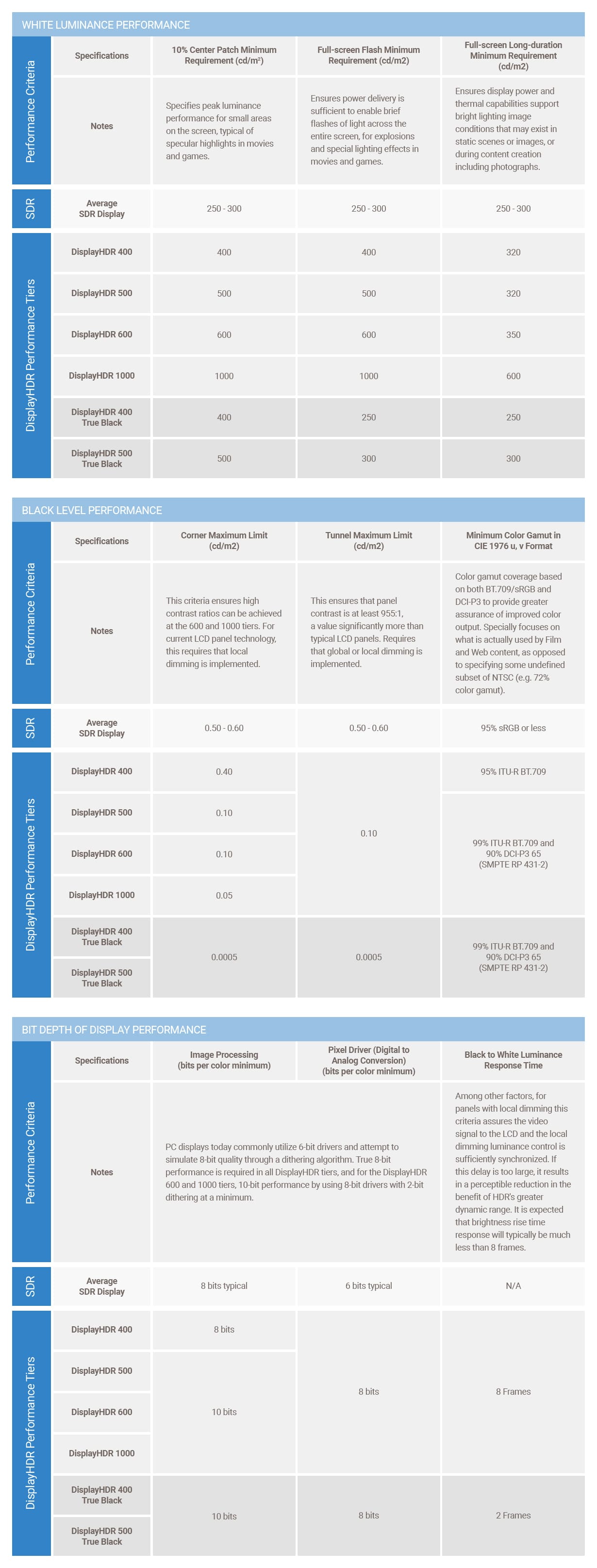VESA Release New HDR Certifications Including ‘True Black’ for OLED and Emissive Displays

Towards the end of 2017 VESA launched a series of certifications designed to help classify HDR in the desktop monitor space. Their ‘DisplayHDR’ specification introduced at the time three tiers of HDR, with DisplayHDR400, 600 and 1000 being available. This represented different levels of HDR performance, with varying requirements in terms of local dimming, contrast, peak brightness etc. You can read about HDR and these VESA standards in our detailed HDR article if you want to know more.
VESA have now announced 3 new tiers in this scheme, including most interestingly the new ‘DisplayHDR True Black’ specifications which designed for “emissive display technologoes, including organic light emitting diode (OLED) and future microLED displays”.
Since its introduction a year ago, VESA’s DisplayHDR standard has seen widespread and growing adoption among LCD display OEMs. To date, nearly three dozen displays across nine display OEMs have been released to market with DisplayHDR certification. Many more are expected to be introduced in the coming months. With the introduction of the new DisplayHDR True Black standard, VESA anticipates a similarly strong adoption curve among OLED display OEMs as has occurred with the DisplayHDR standard.
” When VESA unveiled the original DisplayHDR standard, we recognized that display technologies were quickly evolving, and we immediately set to work on developing a new open HDR standard for OLED and other emissive display technologies,” stated Roland Wooster, chairman of the VESA task group responsible for DisplayHDR, and the association’s representative from Intel Corporation for HDR display technology. “On behalf of all of the VESA member companies that contributed to the DisplayHDR True Black specification, I’m pleased to say that we are fulfilling our promise with today’s announcement. We’re extremely proud of this incredible, high contrast and high dynamic range standard. Consumers benefit from the transparency of the DisplayHDR True Black specification and logo, which makes it clear that they’re getting a display that yields huge performance improvements in subdued lighting environments.”
DisplayHDR True Black allows for up to 100X deeper black levels in addition to a greater dynamic range and a 4X improvement in rise time (i.e. faster backlight changes with change from black to white) compared to VESA’s DisplayHDR 1000 performance tier. This enables a visually stunning experience for home theater and gaming enthusiasts in subdued lighting environments. DisplayHDR True Black is the display industry’s first fully open standards specifying HDR quality emissive display.
On LCD displays, what is considered “black” is actually a very dark grey tone, which is a result of minor light leakage common with these displays. VESA defined the new DisplayHDR True Black specification with emissive displays like OLED in mind to bring the permissible black level down to 0.0005 cd/m2 – the lowest level that can be effectively measured with industry-standard colorimeters. For gamers and movie watchers in subdued lighting environments, displays adhering to the DisplayHDR True Black specification can provide incredibly accurate shadow detail and dramatic increases in dynamic range (up to 50X depending on lighting condition) for a truly remarkable visual experience.
Of course the one thing missing here is any OLED or emissive displays in the desktop monitor market! We’ve seen the odd screen announced or appear briefly in the past, but the desktop monitor market really doesn’t have any displays with this technology right now. You might remember Dell’s UP3017Q display, a 30″ premium display with OLED, which was showcased at CES in 2016 (3 years ago!). This then emerged in some regions like USA and Canada but then was quickly withdrawn, never making it to Europe in fact. More recently at CES in January 2018 Asus announced their ProArt PQ22UC which was a 21.6″ sized OLED screen for professional applications. This has still yet to emerge for retail, and it’s unclear whether it ever will. Right now this new ‘True Black’ certification could be considered a bit pointless for desktop monitors, but history does show us that CES is the place where manufacturers like to announced OLED screens, so perhaps we will see more start to emerge at this years event in a few days (8 – 11th Jan 2019). Time will tell, but this new VESA HDR certification scheme is here to help classify HDR if and when displays do start to appear.
VESA DisplayHDR 500 for LCD’s also announced

VESA also announced that it has added a new 500 performance level to both the DisplayHDR and the DisplayHDR True Black standards to address the need for thin, ultra-lightweight HDR laptops. The new 500 level includes local dimming as well as the same color gamut, black level and bit-depth requirements associated with the 600 and 1000 levels with a slightly lower luminance requirement compared to the 600 level, to bring about better thermal control in displays for super-thin notebooks. While the new 500 level is optimized for very small, ultra-slim displays, it actually applies to all resolutions and screen sizes, including those used in monitors. So basically it’s the same kind of requirements as the previous HDR600, just with a more lenient peak brightness requirement.

The specifications for the VESA DisplayHDR standards including the new 500 and True Black 400 and True Black 500 levels can be seen below:

Source: DisplayHDR.org
